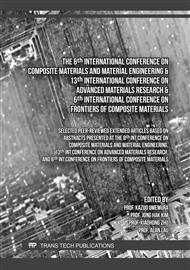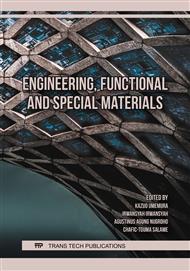[1]
NHI. 2000. NHI Course #131053 Superpave Fundamentals Reference Manual. FHWA-NHI131053. National Highway Institute, Washington, DC. https://idot.illinois.gov/Assets/uploads/files/Transportation-System/Manuals-Guides-&-Handbooks/T2/P028.pdfp. 119
Google Scholar
[2]
Y.-R. Kim, F. Aragao, and J. Lutif. Restricted-Zone Requirements for Superpave Mixes Made with Local Aggregate Sources, NDOR Research Project Number P556 (2006).
Google Scholar
[3]
R.C. Williams, A. Buss, J. Podolsky, H.D. Lee. Y. Validation of Gyratory Mix Design in Iowa – Phase II, IHRB Project TR-742 (2021).
Google Scholar
[4]
R. Cominsky, R.B. Leahy, E.T. Harrigan. Level One Mix Design: Materials Selection, Compaction, and Conditioning. SHRP A-408 report (Level One Mix Design: Materials Selection, Compaction, and Conditioning (1994).
Google Scholar
[5]
J.G. Speight. Asphalt Materials Science and Technology. 1st edition, Amsterdam, Butterworth-Heinemann (2015)
Google Scholar
[6]
Y.J. Xue, S.P. Wu, H.B. Hou. J. Zha. Experimental investigation of basic oxygen furnace slag used as aggregate in asphalt mixture. J. Hazard. Mater, 138, 261–268, (2006)
DOI: 10.1016/j.jhazmat.2006.02.073
Google Scholar
[7]
J. Xie, S. Wua, J. Lin, J. Cai, Z. Chen, W. Wei. Recycling of basic oxygen furnace slag in asphalt mixture: Material characterization & moisture damage investigation. Constr. Build. Mater. 36, 467–474, (2012)
DOI: 10.1016/j.conbuildmat.2012.06.023
Google Scholar
[8]
L-S. Huang. Evaluation of the Cooling and Pavement Performance of Basic Oxygen Furnace Slag Used in Asphalt Mixture. Applied Sciences. 7(12):1226, (2017)
DOI: 10.3390/app7121226
Google Scholar
[9]
H. Wen, S. Wu, S. Bhusal. Performance evaluation of asphalt mixes containing steel slag aggregate as a measure to resist studded tire wear. Road Materials and Pavement Design, DOI: 10.1080/14680629.2019.1620120, (2015).
DOI: 10.1061/(asce)mt.1943-5533.0001475
Google Scholar
[10]
M.L. Pattanaik, R. Choudhary, B. Kumar, and A. Kumar. Mechanical properties of open graded friction course mixtures with different contents of electric arc furnace steel slag as an alternative aggregate from steel industries. Road Materials and Pavement Design, 22(2), (2021)
DOI: 10.1080/14680629.2019.1620120
Google Scholar
[11]
H. Ziari, S. Nowbakht, S. Rezaei, and A. Mahboob. Laboratory investigation of fatigue characteristics of asphalt mixtures with steel slag aggregates. Advances in Materials Science and Engineering, 1–5, (2015).
DOI: 10.1155/2015/623245
Google Scholar
[12]
Z. Chen, S. Wu, Y. Xiao, W. Zeng, M. Yi, and J. Wan. Effect of hydration and silicone resin on Basic Oxygen Furnace slag and its asphalt mixture. Journal of Cleaner Production, 112, 392–400, (2016)
DOI: 10.1016/j.jclepro.2015.09.041
Google Scholar
[13]
Y. Ye, S. Wu, C., Li, D. Kong, B. Shu. Morphological discrepancy of various basic oxygen furnace steel slags and road performance of corresponding asphalt mixtures, materials. 12(14):2322, (2019)
DOI: 10.3390/ma12142322
Google Scholar
[14]
Z. Liu, X. Li, D. Deng, G.D. Schutter, and L. Hou. The role of Ca(OH)2 in sulfate salt weathering of ordinary concrete, Constr. Build. Mater. 123, 127–134, (2016)
DOI: 10.1016/j.conbuildmat.2016.07.006
Google Scholar
[15]
A. Tukaziban, C.-S. Shon, I. Orynbassarov, S. Sandybay, D. Syzdykov, D. Zhang, and J.R. Kim. Mechanical, swelling, and thermal properties of geopolymer mixture containing basic oxygen furnace slag aggregates, In: IOP Conference Series: Earth and Environmental Science. 1050, 1, 012021, (2022).
DOI: 10.1088/1755-1315/1050/1/012021
Google Scholar



